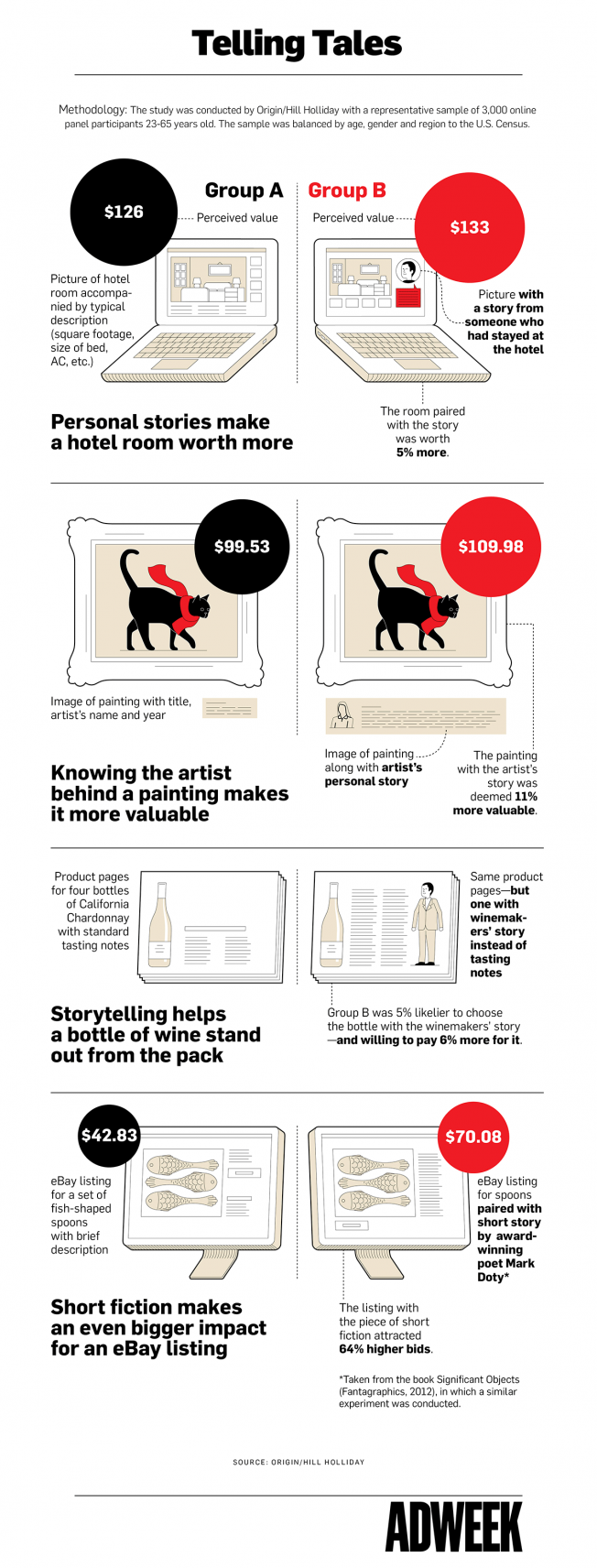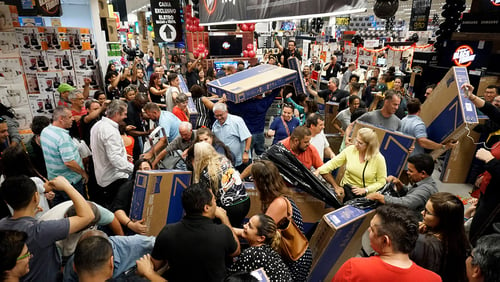Is brand storytelling all one big myth?

Posted by Lisa Sills
July 3rd, 2018
If you’ve dabbled in the world of digital, there’s no doubt you’ve stumbled across the much-maligned notion of brand storytelling.
If your brand is anyone, it absolutely should be doing brand storytelling.
Brand storytelling, here, means the application of storytelling techniques, characterisation, and narrative to execute brand strategy.
It’s taking the onus from the brand and its selling potential and placing it squarely on emotive content. Instead of avenue A and, “this is my product and why you should buy it,” it goes to avenue B and, “here’s a story about the implicit worth of this brand that might actually make you cry, but in a good way, I promise.”
A suitcase and a bearded ginger walk into…the Himalayas
A spectacular example of brand storytelling is DELSEY Paris, a luggage company, and its excellent animated short film.
In three and a half minutes, DELSEY Paris tells the story (!) of Simon, son of a now-deceased, hardy explorer. An overworked millennial trapped in a job he hates, Simon’s left a letter from his dearly departed dad.
Simon, as any great hero, must go on a quest to find an inheritance of ‘immense value’, locked away in a connected suitcase. Simon connects to the DELSEY site on his phone and off he globe-trots.
Along the way, he falls into a mire of familiar storytelling beats: his beard grows out and he discovers both himself and how to be free among the mythos of the world and without the chagrin of his daily life.
With his trusty suitcase too – as this is, after all, an advert for a luggage company.
Had DELSEY taken the easier (and much more inexpensive) route, they’d have filmed a traditional ad of people lugging their suitcase around. Cue close-ups of laughing parents and happy children having a great time on holidays.
Instead, the company leaned into the idea of brand storytelling and created a myth of their own: Simon’s is a story with a beginning, a middle, and an end; it’s the quintessential hero’s quest to find his preciousssss.
But did the animation shift suitcases? Or is this the kind of activation an agency does as a showpiece because it can?
Brand storytelling: is it all a crock of shit?
Philip Pullman, literary bae and author of celebrated works including the Golden Compass, once said, “After nourishment, shelter and companionship, stories are the thing we need most in the world.”
Of course, that’s a starry-eyed, arbitrarily writer-y view. (We’d list internet connectivity above ‘stories’, for one.)
And as it pertains to brands, do we really need stories from Coca-Cola, Airbnb, Google or the local corner shop down the road?
Simple answer? No. We don’t *need* stories – and certainly not those from brands. We don’t need anything beyond the basic sustenance that keeps us alive – but where’s the fun in that?
Indeed, it’s not a question of need but of solipsism, where you and your brand live slap-bang in the centre of your universe.
Brand storytelling intends to make owned media work harder. It’s easy to dismiss it as a marketing-induced crock, where over-stretched staffers are trying to find new ways to peddle the same thing.
But go back to DELSEY. Why spend all that money engaging an agency and hiring motion graphics artists to create a beautiful three and a half minute animation if it isn’t going to get attention? The original video upload to DELSEY’s Facebook (where, appropriately, it’s referred to as ‘our new movie’) had over 26,000 views, organically, with re-uploads notching up thousands more.
Off hand, can you think of a more effective ad for a suitcase?
The library is open (or the old ways are dead)
There’s a further library of brand stories that are being heard, devoured, and shared.
GoPro, Lego (ergo: the Lego movie and its sequel are elaborate ventures into brand storytelling), the Dollar Shave Club, Dove, BrewDog, Smirnoff for equality, and Always’ Like a Girl.
Like seasoned mischief-makers Paddy Power before it, Scottish beer-maker BrewDog peddles in attention-grabbing, story-telling stunts.
Some of the brand’s ‘better’ guerrilla activations include a Viagra beer to celebrate the Royal Wedding and an incredibly odd venture where it packaged its ale inside the bodies of dead animals dressed in little outfits.
Macabre – but it piqued interest.
In an article for The Drum, Jeff MacDonald writes, “The obituary for the old form of brand is increasingly written across the marketing and business press.
"The death of the outdated transactional relationship between brands and people has been signalled very clearly by the Havas Media Meaningful Brands study.
"The need for a radical overhaul in thinking on propositions and activation could not be clearer. Headline findings in the most recent 2017 study include the damning facts that people wouldn’t care if 74% of the brands they use just disappeared and that 60% of the content created by the world’s leading 1,500 brands is ‘just clutter’ that has little impact on consumers’ lives (or business results)."
The value of brand storytelling comes down to ethos; does your brand really believe in content? In emotion? Is it important for you to use brand storytelling as a strategic pinwheel for marketing success?
When you think of successful brands, you think of the storytellers: the Doves, the Cokes, the Adidas and Nikes.
Ultimately it comes down to this: no one wants to be sold to, but tell them an engaging story, and they’ll listen. And in a constantly disrupted marketing landscape, being heard is a commodity all of its own.
In one final nod towards the power of brand storytelling, take a look at this branding infographic from Adweek.

As Ikea says (via ~✨brand storytelling✨~) in its ‘Wonderful everyday’ campaign: It’s the small things that matter.
https://youtu.be/1KwfxOfNJXY
Brand storytelling: mistakes to avoid
We could use examples to argue for the merit of brand storytelling all day; instead we’re giving you five quick tips to start telling your own stories.
1. You (or your brand) are not the hero
Every story ever told falls into one of three categories:
- Hero falls in love.
- Hero dies.
- Hero goes on a quest.
Sometimes, Hero experiences all of these things at once.
When it comes to your brand and telling a story, the key thing to remember is that you (or your brand) are not the hero.
Say it with me: You. Are. Not. The. Hero.
Tell a story about your company and its existence and you’ve got a run-of-the-mill corporate explainer. Reach for better.
2. Have a purpose
Set your marketing goals, absolutely, but beyond that, know what you want from your audience. How do you want them to feel? What do you want them to do?
Create something that will encourage them to feel or do.
(That’s never as easy as it sounds.)
Establish a plot, your setting, a narrator, and a point of view. Above all else, make sure the idea passes the ‘who cares?’ litmus test.
3. Remember that brand storytelling isn’t just a big budget gamble
As much as marketing is about the big plays, it’s also about capitalising on little wins; on increasing CTR by changing the colour of a button or a better CPA by editing copy in a product description or driving a lower CPC because you changed the CTA to something less passive.
Every story doesn’t have to be an opus. Experiment and entertain the small wins too.
4. Know your audience
Depart from your ivory tower and get to know your audience.
Many marketing fails happen because brands don’t know theirs.
Take Free People for example. Free People is a clothing company which launched a new line targeting ballerinas, surfers, and women who do yoga.
The brand released a video showcasing the clothes.
It’s a perfectly nice video.
The problem?
Dancers and ballerinas tore it to shreds, with hundreds of angry comments. Downvotes on YouTube outpaced upvotes by 4.1k to 688.
Free People made an assumption based on what its audience would accept.
Clearly, it was wrong. Bad move.
5. Brand storytelling should never exist in a vacuum
Brand storytelling works for lots of brands – but it’s not a strategy. Creating something beautiful and frittering it out into the world probably isn’t going to work. Even the most innocuous of product launches needs thought and care.
Brand storytelling may be a framework for activation but sales and sustained loyalty rely on great products, interesting promotions, and marketing that matters. Successful marketers need to ditch the ‘one-off’ ephemeral mindset and instead focus on sustainable digital and traditional activities.
Brand storytelling may well be the bedrock of your brand but it isn’t your brand – and that’s where the myth is.
As per writer Sue Monk Kidd, “Stories have to be told or they die, and when they die, we can’t remember who we are or why we’re here.”
Brands are the same: tell your story or fade away.
Ultimately, the world is made of stories. Make yours.
Want to build your brand with storytelling?
Interested in telling your brand's story? Get in touch and we can help.

Lisa Sills

Previous Post
The death of the old textbook SEO strategy: Why quality content matters more than ever
Next Post

Global win for 256 in Content Marketing Awards
Subscribe Here
You may also like...
Nadia Reckmann | Aug 16, 2024
Nadia Reckmann | May 30, 2024
Nadia Reckmann | Nov 23, 2023





